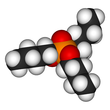Tributyl phosphate

| |||
| |||
| Names | |||
|---|---|---|---|
| Preferred IUPAC name
Tributyl phosphate | |||
| Identifiers | |||
3D model (JSmol)
|
|||
| ChEBI | |||
| ChemSpider | |||
| ECHA InfoCard | 100.004.365 | ||
| KEGG | |||
PubChem CID
|
|||
| UNII | |||
CompTox Dashboard (EPA)
|
|||
| Properties | |||
| C12H27O4P | |||
| Molar mass | 266.318 g·mol−1 | ||
| Appearance | Colorless to pale-yellow liquid[1] | ||
| Density | 0.9727 g/mL | ||
| Melting point | −80 °C (−112 °F; 193 K) | ||
| Boiling point | 289 °C (552 °F; 562 K) | ||
| 0.4 g/L[2] | |||
| Vapor pressure | 0.004 mmHg (25°C)[1] | ||
| Hazards | |||
| Safety data sheet | External MSDS | ||
| NFPA 704 (fire diamond) | 
2
1
1 | ||
| Flash point | 146.1 °C (295.0 °F; 419.2 K) | ||
| Lethal dose or concentration (LD, LC): | |||
LD50 (median dose)
|
1189 mg/kg (mouse, oral) 3000 mg/kg (rat, oral)[3] | ||
LC50 (median concentration)
|
227 ppm (cat, 4–5 h) 123 ppm (rat, 6 h) 117 ppm (rat) 2529 ppm (rat, 1 h)[3] | ||
LCLo (lowest published)
|
2214 ppm (cat, 5 h)[3] | ||
| NIOSH (US health exposure limits): | |||
PEL (Permissible)
|
TWA 5 mg/m3[1] | ||
REL (Recommended)
|
TWA 0.2 ppm (2.5 mg/m3)[1] | ||
IDLH (Immediate danger)
|
30 ppm[1] | ||
Except where otherwise noted, data are given for materials in their standard state (at 25 °C [77 °F], 100 kPa). | |||
| Infobox references | |||
Tributyl phosphate, known commonly as TBP, is an organophosphorus compound with the chemical formula (CH3CH2CH2CH2O)3PO. This colourless, odorless liquid finds some applications as an extractant and a plasticizer. It is an ester of phosphoric acid with n-butanol.
Production[]
Tributyl phosphate is manufactured by reaction of phosphoryl chloride with n-butanol.[4]
- POCl3 + 3 C4H9OH → PO(OC4H9)3 + 3 HCl
Production is estimated at 3,000–5,000 tonnes worldwide.[5]
Use[]
TBP is a solvent and plasticizer for cellulose esters such as nitrocellulose and cellulose acetate. It forms stable hydrophobic complexes with some metals; these complexes are soluble in organic solvents as well as supercritical CO2. The major uses of TBP in industry are as a component of aircraft hydraulic fluid, brake fluid, and as a solvent for extraction and purification of rare-earth metals from their ores.[5]
TBP finds its use as a solvent in inks, synthetic resins, gums, adhesives (namely for veneer plywood), and herbicide and fungicide concentrates.
As it has no odour, it is used as an anti-foaming agent in detergent solutions, and in various emulsions, paints, and adhesives. It is also found as a de-foamer in ethylene glycol-borax antifreeze solutions.[citation needed] In oil-based lubricants addition of TBP increases the oil film strength. It is used also in mercerizing liquids, where it improves their wetting properties. It can be used as a heat-exchange medium.[6] TBP is used in some consumer products such as herbicides and water-thinned paints and tinting bases.[7]
Nuclear chemistry[]
A 15–40% (usually about 30%) solution of tributyl phosphate in kerosene or dodecane is used in the liquid–liquid extraction (solvent extraction) of uranium, plutonium, and thorium from spent uranium nuclear fuel rods dissolved in nitric acid, as part of a nuclear reprocessing process known as PUREX.
The shipment of 20 tons of tributyl phosphate to North Korea from China in 2002, coinciding with the resumption of activity at Yongbyon Nuclear Scientific Research Center, was seen by the United States and the International Atomic Energy Agency as cause for concern; that amount was considered sufficient to extract enough material for perhaps three to five potential nuclear weapons.[8]
Hazards[]
In contact with concentrated nitric acid the TBP-kerosene solution forms hazardous and explosive red oil.
References[]
- ^ Jump up to: a b c d e NIOSH Pocket Guide to Chemical Hazards. "#0625". National Institute for Occupational Safety and Health (NIOSH).
- ^ Velavendan, P; Sachithanantham, Ganesh; Pandey, N.K.; Geetha, R; Ahmed, M; Mudali, Kamachi; Natarajan, Rajamani (2012). "Studies on solubility of TBP in aqueous solutions of fuel reprocessing". Journal of Radioanalytical and Nuclear Chemistry. 295 (2): 1113–1117. doi:10.1007/s10967-012-1945-1.
- ^ Jump up to: a b c "Tributyl phosphate". Immediately Dangerous to Life or Health Concentrations (IDLH). National Institute for Occupational Safety and Health (NIOSH).
- ^ G. R. Dutton and C. R. Noller (1943). "n-Butyl phosphate". Organic Syntheses.; Collective Volume, 2, p. 109
- ^ Jump up to: a b "Tributyl Phosphate | SIDS Initial Assessment Profile" (PDF). Japan Chemical Industry Ecology-Toxicology & Information Center. Archived from the original (PDF) on 2007-10-11.
- ^ "Tributyl Phosphate Product Information". Great Vista Chemicals.
- ^ "Tributyl Phosphate". Scorecard.
- ^ "Yongbyon - North Korean Special Weapons Facilities". GlobalSecurity.org.
- Organophosphates
- Solvents
- Plasticizers
- Radioactive waste
- Chelating agents
- Phosphate esters

